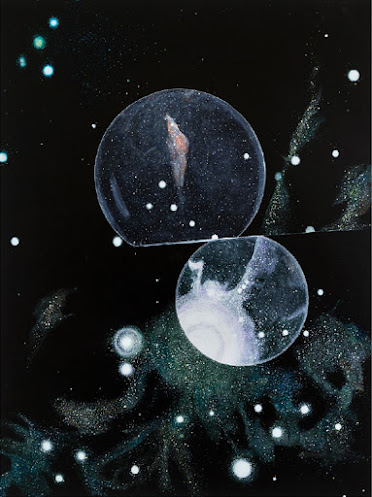BRETT COLQUHOUN - 'TRANSPIRES'
Sutton Gallery - 3rd Sept - 8th Oct 2022
The show consists of nineteen works, all acrylic on canvas, eleven mostly smaller ones are presented salon style in the smaller gallery, nine larger ones fill the main gallery. The suite of smaller works, share the title of Impending while the larger ones, mostly use the theme of Telescope and the show as a whole is titled Transpires. As with recent shows, the artist alternates between park or garden settings and scenes of outer space, each built upon a formal, linear constraint to the foreground.
Telescope (Andromeda) (2021) 180 X 135cm acrylic on canvas
This is such a novel and bold concept played against what are not much more than stock backgrounds of parkland and outer space that one struggles to grasp the formal arrangement, a metaphor for experience, for presence as a person. Yet so much of the artist’s long and quietly assured career has ploughed such a singular furrow it should come as no surprise that he ascends to quite expansive terms by this stage and that it should perfectly reflect the doubt to today’s art world – indeed, grasp of the world.
The artist’s background is in commercial illustration, mainly of children’s books, and venturing into fine art in the early eighties was more an escape from the strictures of illustration. It was pursued as relaxation or perhaps therapy rather than following art world fashions, in other words. Understandably, his work was some distance from the local fashions of the day, neither Neo-Expressionist allegory, Post Pop or Post Modern pastiche, yet somehow it found favour. The artist was included in the Sydney Perspecta in 1983, at the age of twenty-five and has continued to be included in prestigious curated shows and local prizes.
This symbolic function was possibly what recommended the work at the time, when Neo-Expressionists tended to strident allegory and Post Modernists extended this to literary and historical allusion, Colquhoun offers something less obvious, more disciplined, more private or personal and undeniably original.
In following years the work lightens, broadens, acquires themes of age or maturity, in works such as Remain (2005) where the rings of a tree trunk record a consolidation of earliest states, perhaps amelioration or balance and stand for a permanence to structure. Other work advances into more schematic territory, taking a torch light viewed front on and a linear radiation to beam as a similar circular source of stability or illumination, in works such as Light 3 (2012).
The light allows a measure of space, a plotting of position that also suggests a reciprocal arrangement, so that space enables a place and vice versa. Hence such works promptly introduce a second circle, a present or mobile point within a larger scheme, a foreground to a greater or past background. In conversation the artist also conceives such pairing as a relation between persons, alternatively enlightening and enlightened. The development of this theme eventually brings us to Telescope of course, but there are several parallel developments that advance the theme in slightly different ways. The first is a series of collages using photographs from vintage copies of Life magazine (the title hardly accidental) under the theme of Backcatalogue (2014).
The other development arises with a series of works titled Breath in 2012, in which a misted patch upon a window pane records a spectator’s presence, obscuring some of the view on the other side of the glass. While an ingenious demonstration of this reflexive relation between foreground and background, art and life, the greater depth or distance to the scene perhaps taxes the artist’s rendering, requiring greater precision and detail in order to ensure the misted glass is strictly legible, but reluctant to be drawn into more photographic treatment that would further confirm it.
In this regard, the looser treatment to the park backgrounds is more successful for this critic, since the wire shapes to the foreground require little more than white lines, their recognition is easier established and latitude to rendering of backgrounds greater and more pointed – we move from line to tone and colour in conspicuous method, with impressive aplomb. Crucially, the scenes remain deserted and while items such as a bench or paths invite figures, what is impending is a contemplation without them, a rendering that places the beholder outside of that, behind no more than a brittle white loop.
In the case of Telescopic views, the exclusion may not be quite as straightforward. In a work such as Telescope (Nebula) (2021) the imagery adopts the pink of advanced telescopic imagery from The Hubble or James Webb satellite telescopes, and acquires at least a gaseous body. Here, given the reflexive nature between foreground circles and distant stars, the colour to the nebula then suggests flesh, posits a person as remote and mysterious as infinite points of illumination. It is surely significant that the artist chooses a vertical or ‘portrait’ format for these works; that lenses or circles align centrally, from head to toe and that what transpires is an intensely guarded encounter.
IMAGES COURTESY OF THE ARTIST AND SUTTON GALLERY
My thanks to both for help in preparing this review.
OTHER RESOURCES
Sutton Gallery
National Gallery of Australia
QAGOMA
Geelong Gallery
Five Walls
NETS Victoria
Caloundra Art Gallery
Rosalyn Oxley9
Silverbox
Geelong Contemporary Art Prize
The Artist's Commercial Illustration













